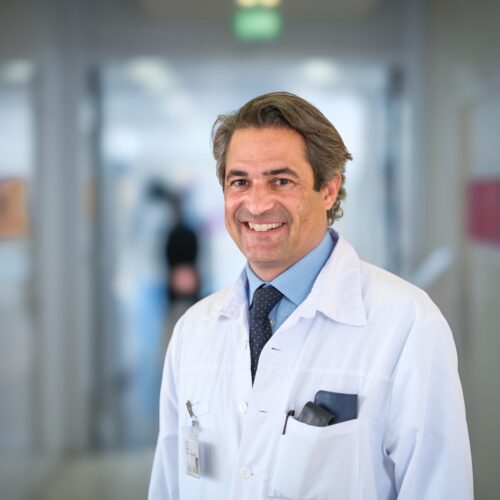- Prof Marc Ansari, MD, PD
CV
Prof Marc Ansari is a Swiss physician with more than 25 years experience in the medical field and specifically in the fields of pediatric hematology, oncology, and genetics. He studied in both Switzerland and Scotland and has worked in hospitals in France, Switzerland and Canada. In 2012, Prof Ansari was appointed to become the head of the pediatric hematology-oncology unit of the Geneva University Hospital (HUG).
After graduation from the University of Geneva in genetics and molecular biology he decided to study medicine and graduated in 2001. He first specialised in paediatrics in Geneva (HUG) and then in hemato-oncology in Montreal where he had a three year fellowship. During this period he also did research in pharmacogenomic and became a partner in Professor M Krajinovic laboratory at the University of Montreal. He made several important discoveries in the fields of genetics, oncology and pharmacology leading to publications and presentations in the most important world congresses specified in these fields (>200 manuscripts). In 2011, he created the first pediatric hematology and oncology research plateforme at the Geneva Medical School (CANSEARCH research laboratory). In order to open and stabilise this research activity he created the CANSEARCH foundation for the children suffering from cancer.
Currently Prof M. Ansari is head of the hematology-oncology unit of the Geneva University Hospital, director of CANSEARCH research laboratory at the université of Geneva.
ABSTRACT
Marc Ansari1,2 on behalf of the FORUM BUPK Consortium.
1 Geneva University Hospitals, Geneva, Switzerland
2 University of Geneva, Geneva, Switzerland
Abstract
The optimal exposure window for busulfan in pediatric patients with acute lymphoblastic leukemia (ALL) undergoing hematopoietic stem cell transplantation (HSCT) has not yet been clearly defined. Our objective was to determine this optimal window for patients receiving busulfan-based chemotherapy conditioning as part of the international, prospective phase III FORUM trial (NCT01949129).
Methods:
We analyzed data from pediatric ALL patients enrolled in the FORUM trial receiving fludarabine-busulfan-thiotepa conditioning. Patients were included if they had measured busulfan plasma levels available from centers that passed cross-validation assessment for busulfan quantification. Busulfan was administered intravenously once, twice, or four times daily according to each center’s practice, and initial dosing was weight-based according to EMA’s summary of product characteristics. Local therapeutic drug monitoring (TDM) procedures, including sampling schedules and exposure estimation, varied widely. To harmonize exposure calculations, we employed a validated population pharmacokinetic (PopPK) model to estimate the cumulative area under the busulfan concentration-time curve (cAUC). Our main outcomes of interest were event-free survival (EFS) and graft-versus-host disease-free relapse-free survival (GFRS). Additional outcomes included relapse incidence, non-relapse mortality, treatment-related toxicities. We identified the optimal busulfan exposure range by examining cAUC thresholds associated with maximal log-rank statistics for EFS and by applying a non-linear covariate relationship within Cox regression to visualize the hazard ratio curve of GFRS over the observed exposure spectrum. Patients were then categorized into optimal, underexposed, or overexposed groups based on these empirically derived cAUC cut-off values, and the outcomes were compared between the exposure groups.
Results:
Data from 145 patients transplanted between 2014 and 2022 were analyzed, with a median follow-up of 4.84 years (IQR 1.92–5.11). The median age at transplantation was 7.5 years (range 0.5–19.5), and 46% of patients were in second or third complete remission. Despite TDM-guided adjustments, substantial variability in busulfan exposure was observed. We identified an optimal busulfan exposure range of cAUC 73.3–98.0 mg.h/L (Figure 1A). Approximately 67% of patients achieved exposure within this range, with 33% of patients falling outside the window. Patients with cAUC values below 73.3 mg.h/L (underexposed) had significantly higher relapse risk (HR 1.93, 95%CI 1.11–3.35, p=0.026), translating to reduced EFS. Overexposure (cAUC >98.0 mg.h/L) did not confer additional protection against relapse. Still, it was associated with increased toxicity risk, including severe graft-versus-host disease and other grade III–IV treatment-related toxicities. Compared to patients within the optimal window, underexposed and overexposed groups had poorer transplantation outcomes, with lower EFS (HR 1.93, 95%CI 1.19–3.14, p=0.008) and GFRS (HR 2.01, 95%CI 1.29–3.13, p=0.002) (Figure 1B). Optimal exposure did not improve overall survival, suggesting efficient rescue procedures following relapse.
Conclusions:
This study delineates an optimal busulfan exposure range (cAUC 73.3–98.0 mg.h/L) for pediatric patients with ALL undergoing HSCT receiving fludarabine-busulfan-thiotepa conditioning regimen as defined in the FORUM protocol. Achieving this range through personalized busulfan dosing guided by therapeutic drug monitoring is essential for optimizing HSCT outcomes in pediatric ALL patients, particularly those who are ineligible for or lack access to total-body irradiation.

